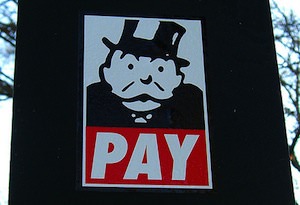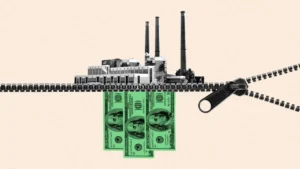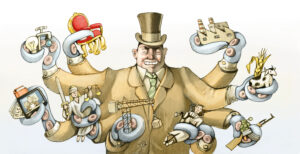How the Rentier Class Cannibalizes the Economy
Rather than mobilizing savings to fund new industries, the banking system that comprises the financial, insurance and real estate sectors merely loads the economy down with debt.
The following is an excerpt from Michael Hudson’s book “The Bubble and Beyond,” published in July 2012 by the Institute for the Study of Long-Term Economic Trends.
As the Industrial Revolution gained momentum, economists anticipated that banking and finance would be absorbed into the industrial system. The attention of economic theorists still remains focused on industrial technology and innovation, and the population shift from agriculture to urban industry. Textbooks (and lobbying exercises) depict bankers as extending credit to enable industrialists to build new factories and employ workers to produce more goods. Loans do not become problematic, but can be paid out of profits generated by the capital investment they finance. This appealing story is used to plead for special tax treatment for financial institutions on the ground that their credit creation adds to economic welfare. Interest is deemed as tax-exempt expenditure, even when corporate raiders use predatory credit.
Yet the symbiosis that has emerged over the past century has been primarily between the financial, insurance and real estate sectors. The great bulk of assets in modern economies — and hence, collateral for bank loans — has been real estate. Some 70 percent of commercial bank lending in the United States and England takes the form of mortgage credit. The estimated market value of real estate exceeds the depreciated value of all the plant and equipment in the entire United States. Loan officers know that the bulk of growth in their bank’s portfolio will consist of mortgage loans. The more rapidly such credit is created, the more funds are channeled into new mortgage financing to bid up the price of real property, making such lending appear self-justifying, at least in the short and intermediate run.
Of the properties financed, land (the value of the site) typically represents about half the total, and all of the capital gain when the property is sold. And the great bulk of depreciation (capital consumption allowances) is reported in the real estate sector. This is because when an industrial machine wears out, it usually must be scrapped in order to keep up with the paces of technological advance. But buildings can be depreciated over and over again, thereby shielding their owners from income-tax liability (especially inasmuch as their interest charges are tax deductible). The upshot is that the tax system (especially in the United States) is much more favorable to real estate than to industry. It is easier to borrow against real property, and the total returns (after-tax earnings plus capital gains) are higher.
The financial industry has fought to support special tax breaks for real estate, recognizing that the money that is freed from the tax collector will be available to pay interest. Political contributions and lobbying efforts by real estate owners are followed by those of the financial sector, overshadowing those of manufacturing. Yet in lobbying for cuts in special gains taxes, both the real estate and financial industries (backed by the insurance industry) present these gains as accruing to industry as a result of innovation, as if this typified modern capitalism. The reality is that most capital gains continue to accrue to real estate. It is only since about 1996 that, for the first time, stock-market gains are beginning to overshadow the growth in real estate gains in the U.S. national balance sheet. The effect is equally corrosive and the reasons for this development are set out in chapter 8 below.
Why don’t economists call a spade a spade and come right out and start their analytic description of modern economics with a profile of where most wealth is accumulated, and the fact that it consists more of land-price gains than growth in manufacturing enterprise? The explanation is to be found in the fact that real estate is by no means as romantic as industry. Most people admire innovators and creators, but resent landlords — and usually also bankers and insurance companies as well, for being more parasitic than creative. There is a general awareness of the obvious fact that the growth in mortgage lending does not add to the supply of land, whose site value is created by public infrastructure investment and the general level of prosperity. In any case, the great bulk of property loans are for land and buildings already in place. The growth of real estate lending thus provides borrowers with credit to compete against each other to buy as many properties as they can, bidding up land prices in the process. The upshot is a bubble, not an industrial boom.
Financial spokesmen argue that this kind of asset-based lending is productive, inasmuch as it provides real estate owners with properties that enable them to pay the interest charges and still (they hope) come out with a capital gain in the end. To help spur this large credit market, the financial lobby has joined hands with the real estate lobby in the United States to gain special tax breaks for real estate.
Bankers know that whatever the tax collector does not take will be left available to pay interest to lenders. Developers bid against each other with regard to the size of the mortgage they will pay the lender, and hence the volume of mortgage debt service they will pay their banker out of rent. This bidding normally continues up to the point where all the available net rental income over costs is paid in the form of interest.
Mortgage lending commonly provides from 80 to 100 percent of the property’s purchase price (or even more as seen in the bubble Economy’s years leading up to the September 2008 crash). This is a highly leveraged rate — it has a high debt/equity ratio. This kind of mortgage debt pyramiding provided the model for junk-bond financing used by corporate raiders in the 1980s, and for the flood of public assets being privatized in Britain, continental Europe and Third World countries. The distinguishing feature of such purchases of real estate, corporations or public entities already in place is that new loans are attached without creating new tangible investment. Instead of new tangible-capital formation there is more typically a downsizing and carve-up as revenue is used to pay interest and amortization up to the maximum extent available over and above operating costs.
The fact is “post-industrial” practice made this dynamic quite different from that which optimists envisioned at the outset of the Industrial Revolution. Instead of mobilizing savings to fund new means of production, today’s banking system merely is loading the economy’s assets down with debt. What seem to be occurring is functionally akin to the pre-industrial mode of lending. The difference is that pre-industrial usury was dominated by individual family lenders, but the new post-industrial debt system is occurring on a large, corporate scale. It has merged with industry primarily to the extent that the financial sector has gained control of the economy’s manufacturing companies, treating them like real estate to squeeze out as large a rentier income as possible and then sell the companies off for a capital gain.
Your support matters…Independent journalism is under threat and overshadowed by heavily funded mainstream media.
You can help level the playing field. Become a member.
Your tax-deductible contribution keeps us digging beneath the headlines to give you thought-provoking, investigative reporting and analysis that unearths what's really happening- without compromise.
Give today to support our courageous, independent journalists.







You need to be a supporter to comment.
There are currently no responses to this article.
Be the first to respond.